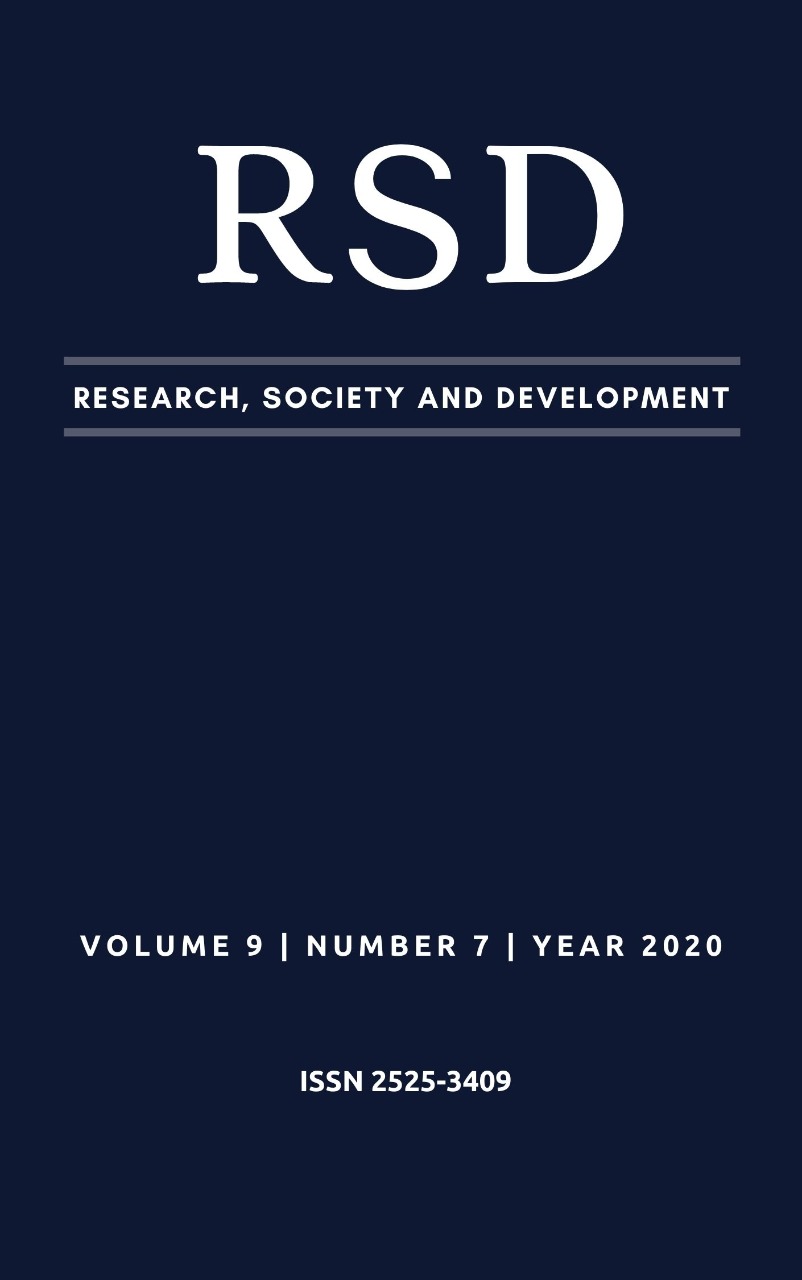Investigation of the relationship between the sinusal ostium diameter and changes in the maxillary sinus: a cone beam computerized tomography study
DOI:
https://doi.org/10.33448/rsd-v9i7.5103Keywords:
Maxillary Sinus; Maxillofacial abnormalities; Tomography.Abstract
Objective: The objective of this study was to relate the sinus ostium diameter with four known changes in the maxillary sinuses by means of cone beam Computed Tomography (CBCT), considering side and gender. Methodology: 415 CBCT scans were evaluated and a total of 328 CBCT scans from patients over 21 years of age were selected for the study. By means of corrected coronal reconstructions in positioning, an anteroposterior scan of the maxillary sinus region was performed to identify, locate, and measure the diameter of the sinus ostium on the right and left sides. Changes in the maxillary sinuses were considered: thickening of the sinus membrane, antral pseudocyst, partial veiling of the maxillary sinus and total veiling of the maxillary sinuses. Results: There was an influence of sex in the presence of sinus alterations, because in the sample, the odds (odds ratio) of men to have any sinus alteration was 2.44 times (p = 0.0002) greater than in women. In general, regardless of gender, there were no statistically significant differences between the diameters of the left (3.27 ± 1.2 mm) and right (3.12 ± 1.12 mm) ostia. There was also no relationship between age and diameter of ostia, and between age and types of changes sinuses. Conclusion: According to the results obtained, it can be concluded that there is no relationship between the diameter of the sinus ostium of the maxillary sinus and the most frequent sinus changes.
References
Almaghrabi BA et al (2011). Treatment of severe sinus infection after sinus lift procedure: a case report. Implant Dent, 20(6), 430- 3.
Anon M&Rontal J (1996). Prophylactic antibiotics in paranasal sinus surgery in infectious diseases and antimicrobial therapy of the ears, nose and throat. Philadelphia/USA: Saunders.
Aust R&Drettner B (1974). The functional size of the human maxillary ostium in vivo. Acta Otolaryngol, 78, 432-435.
Block MS&Dastoury K (2014). Prevalence of sinus membrane thickening and association with unhealthy teeth: a retrospective review of 831 consecutive patients with 1,662 cone-beam scans. J Oral Maxillofac Surg, 72 (24), 54-60.
Brüllmann DD et al (2012). Correlation of cone beam computed tomography (CBCT) findings in the maxillary sinus with dental diagnoses: a retrospective cross-sectional study. Clin Oral Investig, 16, 1023-9.
Carmeli G et al (2011). Antral computerized tomography pre-operative evaluation: relationship between mucosal thickening and maxillary sinus function. Clin Oral Implants Res, 22 (1), 78-82.
Cha JY; Mah J&Sinclair P (2007). Incidental findings in the maxillofacial area with 3-dimensional cone-beam imaging. Am J Orthod Dentofacial Orthop, 132, 7-14.
Gracco A et al (2012). Prevalence of incidental maxillary sinus findings in Italian orthodontic patients: a retrospective cone-beam computed tomography study. Korean J Orthod, 42, 329-34.
Kretzschmar DP&Kretzschmar JL (2003). Rhinosinusitis: review from a dental perspective. Oral Surg Oral Med Oral Pathol Oral Radiol Endod, 96 (2), 128-35.
Lana JP et al (2012). Anatomic variations and lesions of the maxillary sinus detected in cone beam computed tomography for dental implants. Clin Oral Implants Res, 23 (12), 1398-403.
Nunes CA et al (2016). Evaluation of Periapical Lesions and Their Association with Maxillary Sinus Abnormalities on Cone-beam Computed Tomographic Images. J Endod., 42, 42-6.
Ogle OE; Weinstock RJ&Friedman E (2012). Surgical anatomy of the nasal cavity and paranasal sinuses. Oral and Maxillofacial Surgery Clinics of North America, 24 (2), 155–166.
Pereira AS et al (2018). Methodologyof cientific research. [e-Book]. Santa Maria City. UAB/NTE/UFSM Editors. Accessed on: June, 3rd, 2020. Available at: https://repositorio.ufsm.br/bitstream/handle/1/15824/Lic_Computacao_Metodologia-Pesquisa-Cientifica.pdf?sequence=1.
Phillips JE et al (2009). Threedimensional analysis of rodent paranasal sinus cavities from X-ray computed tomography (CT) scans. Can J Vet Res., 73 (3), 205-11.
Phothikhun S et al (2012). Cone-beam computed tomographic evidence of the association between periodontal bone loss and mucosal thickening of the maxillary sinus. J Periodontol., 83, 557-64.
Raghav M et al (2014). Prevalence of incidental maxillary sinus pathologies in dental patients on cone-beam computed tomographic images. Contemp Clin Dent., 5, 361-5.
Rege IC et al (2012). Occurrence of maxillary sinus abnormalities detected by cone beam CT in asymptomatic patients. BMC Oral Health., 10 (12) 30.
Ritter L et al (2011). Prevalence of pathologic findings in the maxillary sinus in cone-beam computerized tomography. Oral Surg Oral Med Oral Pathol Oral Radiol Endod., 111, 634-40.
Smith KD et al (2010). The prevalence of concha bullosa and nasal septal deviation and their relationship to maxillary sinusitis by volumetric tomography. Int J Dent., pii: 404982.
Timmenga NM et al (1997). Maxillary sinus function after sinus lifts for the insertion of dental implants. J Oral Maxillofac Surg., 55 (9), 936-9.
Van Zyl AW&Van Heerden WFP (2009). A retrospective analysis of maxillary sinus septa on reformatted computerised tomography scans. Clin. Oral Impl. Res. 1398–1401.
Downloads
Published
How to Cite
Issue
Section
License
Authors who publish with this journal agree to the following terms:
1) Authors retain copyright and grant the journal right of first publication with the work simultaneously licensed under a Creative Commons Attribution License that allows others to share the work with an acknowledgement of the work's authorship and initial publication in this journal.
2) Authors are able to enter into separate, additional contractual arrangements for the non-exclusive distribution of the journal's published version of the work (e.g., post it to an institutional repository or publish it in a book), with an acknowledgement of its initial publication in this journal.
3) Authors are permitted and encouraged to post their work online (e.g., in institutional repositories or on their website) prior to and during the submission process, as it can lead to productive exchanges, as well as earlier and greater citation of published work.

